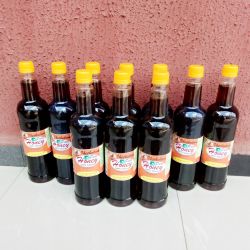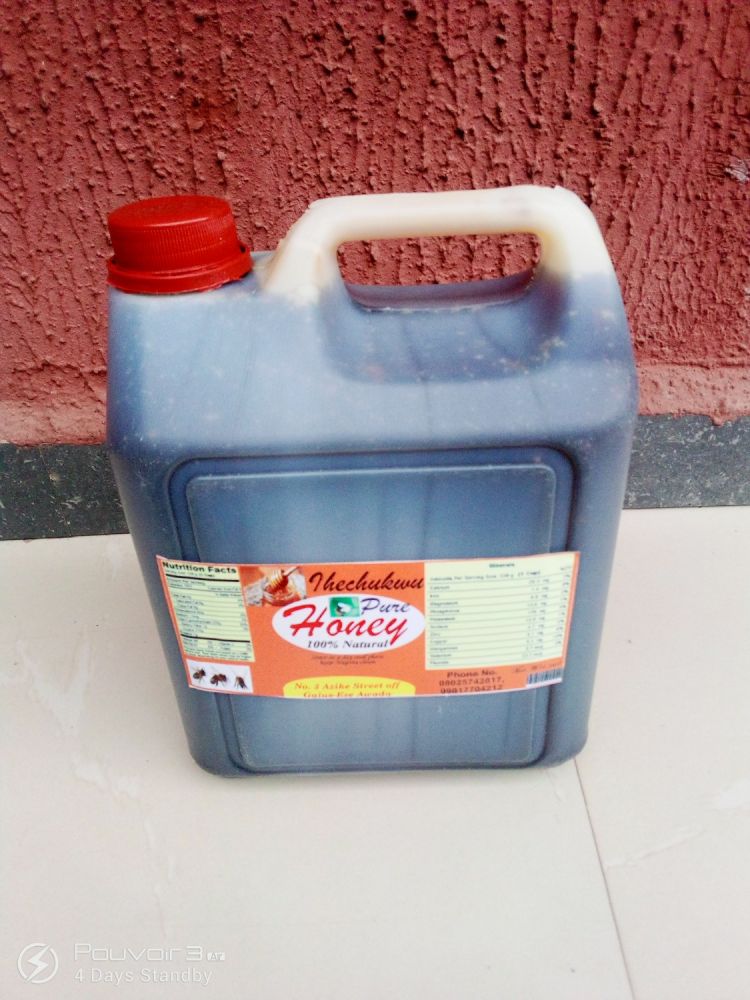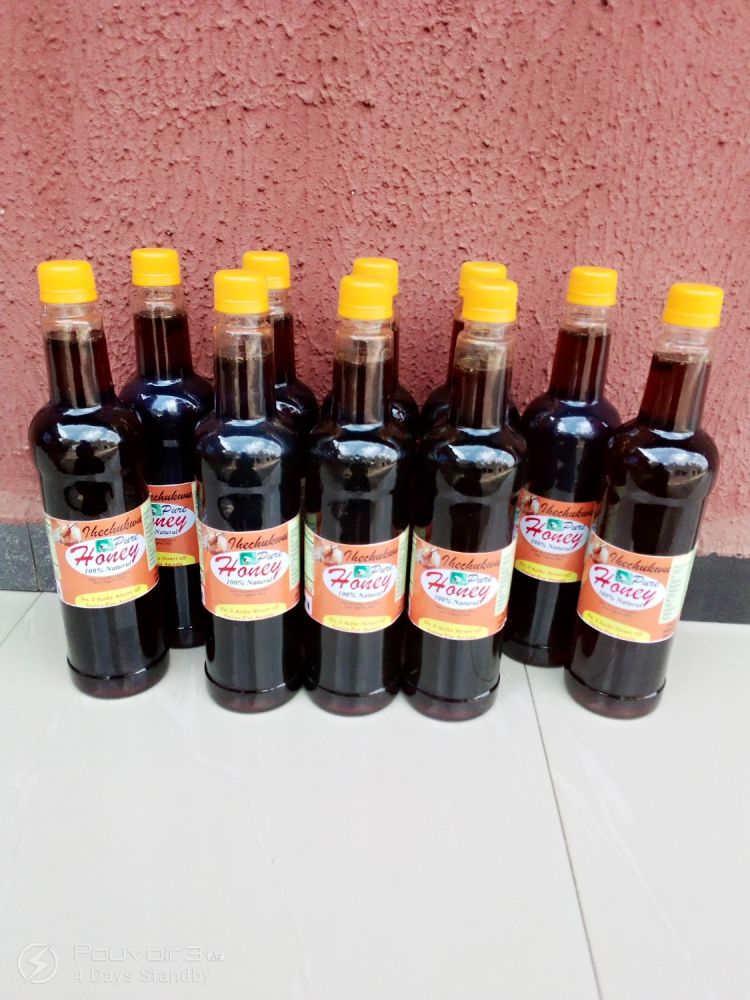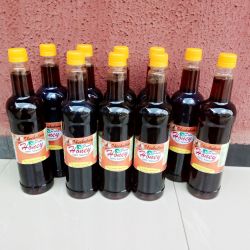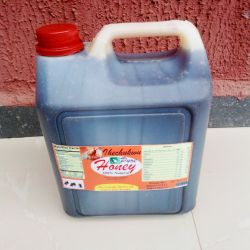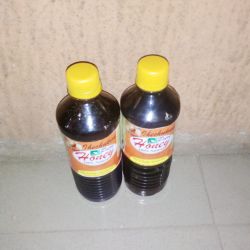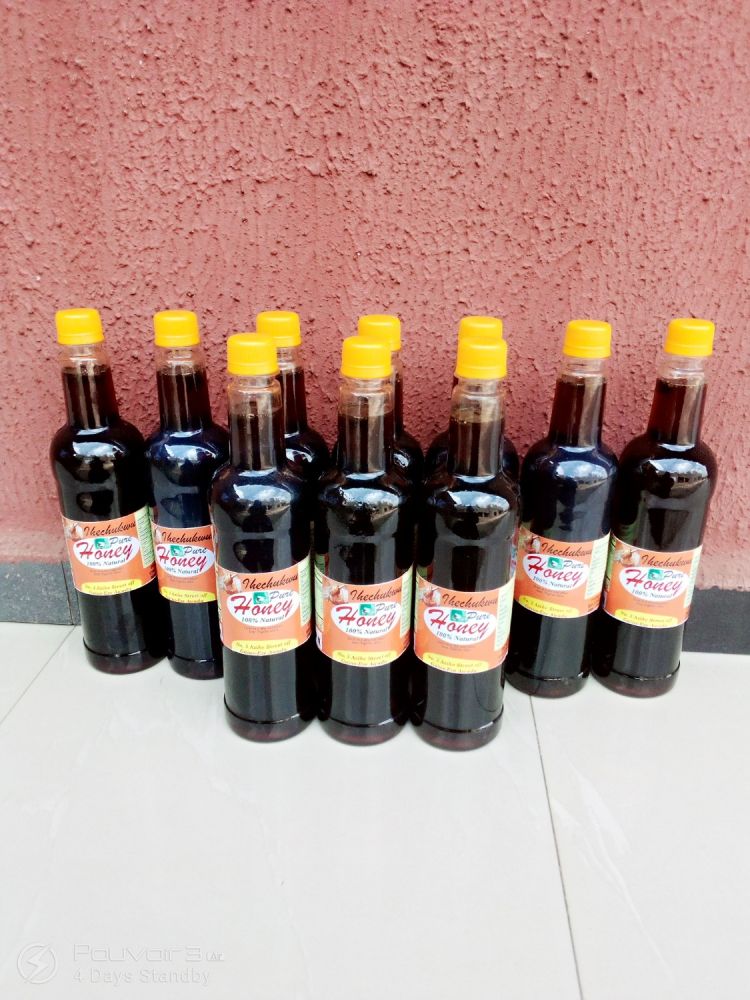Ihechukwu Pure Honey
Recharge Card Printing Training
Production like home made remedy etc.
Honey
What is Honey ?
Pure liquid honeyMature honeybees collect nectar from plant blossoms. Nectar is 80 to 95 percent water and 5 to 20 percent sucrose (table sugar). As the bee transports the nectar back to the hive, a protein enzyme in her honey stomach, called invertase, breaks the sucrose down into the two simple sugars, fructose and glucose.
Young bees remove water from the sugar solution using two methods. They pass the nectar from bee to bee and 'drink' the water out of the nectar by absorbing it through their stomach wall. They also create heat and air flow in the hive by vibrating their wings and flight muscles, thus evaporating water out of the nectar which has been stored in open cells.
When most of the sucrose has been converted to fructose and glucose AND enough water has been dehydrated out of the mixture to bring it approximately 17.8% water content, we have a delicious sticky mixture, called honey!
After honey is made, bees cap it with beeswax to maintain the low moisture content.
Learn more about:
Honey Processing - from "Raw" to "Pasteurized"
Varieties of Honey
Nutritional Value of Honey
Honey Crystallization
Storing Honey
Honey and Infants
Honey and Health
See our selection of natural honey products.
Honey Processing
Honeycomb ready to eat !Many years ago, beekeepers crushed honeycomb to get liquid honey! That method of honey processing produces less honey for the beekeeper as it forces bees to spend time and resources building replacement comb rather than making more honey. Honeybees consume 7 kilograms of honey to produce 1 kilogram of beeswax. The advent of the centrifugal extractor, allowed beekeepers to 'scratch' or 'slice' off a thin layer of wax from the surface of the comb and spin the honey out using centrifugal force. The integrity of the comb is maintained and the bees have far less work to do to repair any cracks or shallow spots in the comb.
Whole honeycomb is available for people who want to enjoy honey completely untouched by human hands. They cut off a bite size portion of wax and chew the honey out of it. Wax will dissolve if chewed for about 15 minutes, but most people discard chewed wax like they would gum.
The vast majority of people prefer liquid honey, so extractors are used to remove honey from the comb. Freshly extracted honey contains bits of wax and the odd bee knee or elbow. Honey may be cleaned by allowing it to settle in a holding tank for a day or two, or by pumping it through a filter.
What is the best type of honey ?
Honeycomb
Untouched by human hands. Contains all the goodness that nature has put into the honey. Bit awkward to chew.
Raw Honey
Extracted and cleaned using a settling tank at room temperature. Contains virtually all the goodness that nature put into the honey. Will granulate quickly and may separate in the jar with liquid fructose on top and granular glucose on the bottom.
Liquid Honey - Filtered with minimal heat
Extracted and cleaned using a 50 micron filter. Honey is heated to the same temperature inside a hive on a hot day. Contains a great deal of the goodness that nature put into the honey. Will granulate in two to six months, depending on the type of flowers the bees visited to gather the honey.
Creamed Honey
Creamed honey is made from pure liquid honey through a controlled crystallization process to produce very fine uniform crystals, thus resulting in a creamy smooth consistency. Creamed honey has nothing added and has the same nutritional value as its liquid counterpart.
Liquid Pasteurized Honey
Extracted and cleaned using flash heating to a high temperature, super filtered through a 1 to 5 micron filter, and quickly cooled. Looses much of the goodness that nature provided, but will last over 9 months on the store shelf without granulating.
Varieties of Honey
The flavour, colour, texture, and aroma of honey depends on which plants the bees gathered nectar from. Blueberry blossom honey is made with the nectar from blueberry blossoms, is dark amber in colour, and has a brown sugar after taste. Raspberry blossom honey is extra light in colour with a slight fruity taste, and buckwheat honey is almost black in colour with a heady, pungent odour and flavour. Generally, a dark honey will have a higher nutritional content than a light honey.
There are hundreds of flowering plants in the world that produce nectar, thus providing the potential to have hundreds of types of honey. Wild flower honeys represent a blend of flowering plants, and varies in colour and flavour depending on region and season.
The Nutritional Value of Honey
Average Composition of Honey
Honey is primarily fructose (38%), glucose (31%), water (17%), maltose (7%), and small amounts of trisaccharides, other higher carbohydrates, sucrose, minerals, vitamins, and enzymes.
Vitamins - trace amounts
Thiamin, Riboflavin, Niacin, Pantothenic acid, Vitamin B-6, Vitamin B-12, Folate, Vitamin C, Vitamin A, Vitamin D, Vitamin E, Vitamin K
Minerals - trace amounts
Calcium, Copper, Iron, Magnesium. Manganese, Phosphorous, Potassium, Sodium, Zinc
Antioxidants - enzymatic and non-enzymatic
Catalase, ascorbic acid, flavonoids
Standard Nutritional Information
Nutritional Facts (per 20 g serving)
LABEL AMOUNT DAILY VALUE
Calories 60
Fat / Lipides 0 g 0 %
Carbohydrates / Glucides
Sugars
17 g
16 g
6 %
Protein 0 g 0 %
Honey Crystallization
Crystallization is the formation of monohydrate glucose crystals from a super-saturated sugar solution (ie. honey).
The rate of crystallization increases with:
Lower water content
Higher glucose content
Presence of solid particles (ie. pollen grains & honey crystals)
Temperature close to 14 C (Temperatures above 28 C and below 5 C result in very slow crystallization)
Stirring
Note that the slower crystallization produces larger and more irregular crystals.
Crystallization of honey is completely normal and does not damage the honey. In most cases the crystallization process can be reversed by gently warming the honey to "melt" the crystals.
How to de-crystalize honey.
Honey that has started to crystallize, characterized by glucose crystals forming on the bottom of the container, can be easily melted. Simply put the honey container (with the lid on) into a warm water bath on the stove at approximately 45 C for a couple hours, or as necessary. Stirring the honey, or turning the container upside down occasionally to break up the crystals, will speed the process.
Storing Honey
Honey is a very robust food product, and if stored properly, will last years if not decades. In fact, honey has been found perfectly preserved in tombs of the Pharaohs in Egypt.
The quality of honey may be damaged by the following factors:
Excessive moisture
Ideally the moisture content of honey should be less than 17.8%. If the moisture content is too high, say greater than 20%, the honey may ferment due to yeasts in the honey. Since honey is hygroscopic, if it is not in a sealed container, it will attract moisture from the air.
Excessive heat
Honey loses many of its' health benefits with the combination of heat and time. The following is a rule of thumb storage time vs temperature to retain most of its' health benefits:
40 C for 30 days
30 C for 6 months
20 C for 4 years
10 C for 35 years
Prolonged exposure to sunlight
Honey loses many of its' health benefits with prolonged exposure to sunlight.
Noxious elements in its environment
Honey is hygroscopic and takes on odours from its environment. It is also acidic, so it can dissolve metal if stored in metal containers.
Honey Storage Guidelines
Store honey in a sealed non-metalic container.
For normal use, store the container in a cupboard (away from direct sunlight) at room temperature (21 C).
For prolonged storage of honey (> 4 years), store at refridgerator temperature (4 C).
Honey and Infants
The bacterium, Clostridium botulinum is very common in nature and any raw food, including honey, may contain Clostridium botulinum spores.
A fully developed digestive system will protect a person against ingested C. botulinum. However, the digestive system of an infant under the age of 12 months is not fully developed, and thus cannot deal with with many kinds of antigens, including C. botulinum. The toxins produced by C. botulinum are extremely dangerous and present a very serious condition for infants.
Honey is a raw food and is NOT recommended for infants less than 12 months of age
It is extremely rare to find C. botulinum in honey, but there have been a hand full of documented cases over the last 40 years. In these cases it is thought that the bacteria came in contact with the honey somewhere during honey processing.
Due to honey's bacteriostatic properties, bacteria, including C. botulinum, will not grow nor produce toxins in honey ! C. botulinum spores are very resilient and can withstand harsh conditions, including the honey pasteurization process. If an infant were to ingest honey that was contaminated with C. botulinum spores, the honey would become diluted in the infant's intestinal tract, and the spores would have suitable conditions to be activated, thus providing the conditions for botulism.
The honey pasteurization process does NOT destroy C. botulinum spores in honey !
Health and Healing with Honey
For thousands of years, the unique antimicrobial and antioxidant properties of honey have been valuable for healing cuts, scapes, burns, and even open wounds.
See About Apitherapy to learn more about health and healing with honey.
Ihechukwu Pure Honey
Honey is available raw and pasteurized and in variety of color grades. On average it contain about 80% sugar. People remove honey from the hive and bottle it directly, so it may also contain trace amounts of yeast wax, and pollen.
MEDICINAL USE OF HONEY
Honey
Lorem ipsum dolor sit amet, consectetur adipiscing elit, sed do eiusmod tempor incididunt ut labore et dolore magna aliqua. Ut enim ad minim veniam, quis nostrud exercitation ullamco laboris nisi ut aliquip ex ea commodo consequat. Duis aute irure dolor in reprehenderit in voluptate velit esse cillum dolore eu fugiat nulla pariatur. Excepteur sint occaecat cupidatat non proident, sunt in culpa qui officia deserunt mollit anim id est laborum.
Lorem ipsum dolor sit amet, consectetur adipiscing elit, sed do eiusmod tempor incididunt ut labore et dolore magna aliqua. Ut enim ad minim veniam, quis nostrud exercitation ullamco laboris nisi ut aliquip ex ea commodo consequat. Duis aute irure dolor in reprehenderit in voluptate velit esse cillum dolore eu fugiat nulla pariatur. Excepteur sint occaecat cupidatat non proident, sunt in culpa qui officia deserunt mollit anim id est laborum.
Lorem ipsum dolor sit amet, consectetur adipiscing elit, sed do eiusmod tempor incididunt ut labore et dolore magna aliqua. Ut enim ad minim veniam, quis nostrud exercitation ullamco laboris nisi ut aliquip ex ea commodo consequat. Duis aute irure dolor in reprehenderit in voluptate velit esse cillum dolore eu fugiat nulla pariatur. Excepteur sint occaecat cupidatat non proident, sunt in culpa qui officia deserunt mollit anim id est laborum.

